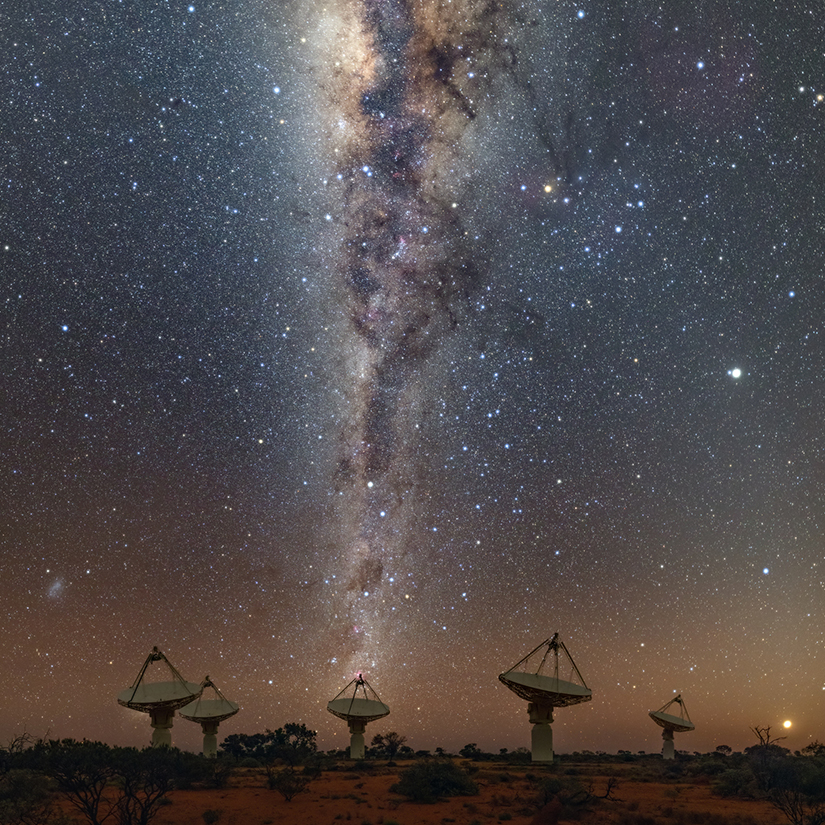W. M. Keck Observatory Astronomers Among the Authors Awarded the 2020 AAAS Newcomb Cleveland Prize
Maunakea, Hawaii – A historic feat in successfully zeroing in on the precise location of a non-repeating fast radio burst has earned the highest recognition from the American Association for the Advancement of Science (AAAS).
The international team that made the breakthrough discovery has won the prestigious 2020 AAAS Newcomb Cleveland Prize, which goes to the most impactful research paper published in the journal Science.
“Given the robust research AAAS publishes across a variety of scientific fields, it’s a great honor to have this work selected for the Newcomb Cleveland Prize,” says W. M. Keck Observatory Chief Scientist John O’Meara, a co-author of the study. “There was a global team of astronomers involved in this work, and it’s wonderful to see such a large collaboration earn this distinction for an exciting science result.”
AAAS made the announcement today at its 187th AAAS Annual Meeting; authors will receive the award tomorrow, February 10, 2021, during a virtual ceremony.
The winning paper, “A single fast radio burst localized to a massive galaxy at cosmological distance,” was published in Science on August 9, 2019 and includes key data obtained using Keck Observatory on Maunakea in Hawaiʻi.
“Keck’s world-leading instrument and the nimbleness of its Target of Opportunity program let us measure the galaxy’s distance within hours after the fast radio burst was localized,” says co-author J. Xavier Prochaska of University of California, Santa Cruz, who coordinated the team that used the Keck Cosmic Web Imager on the Keck II telescope to measure the distance of the FRB’s home.

They traced it back to a galaxy called DES J214425.25−405400.81, located 3.6 billion light-years away from Earth.
FRBs are extremely bright, powerful flashes of radio waves that disappear in the blink of an eye, lasting less than a millisecond. This makes it a challenge detecting these signals, let alone pinpointing their source to then accurately measure their distance.
To catch one, the team, led by Keith Bannister of the Commonwealth Scientific and Industrial Research Organization (CSIRO), developed a new detection method using the Australian Square Kilometre Array Pathfinder (ASKAP) radio telescope, which consists of an array of 36 dish antennas. Because they’re spread across about 4,000 square meters, FRB 180924’s radio waves traveled to each antenna at very slightly different times, just a fraction of a billionth of a second. Bannister’s team was able to replay the data from each dish and triangulate the FRBs source. Follow-up observations using Keck Observatory as well as the Very Large Telescope (VLT) and Gemini South, both in Chile, then revealed the burst’s birthplace.
Astronomers can now further probe and characterize its host galaxy to investigate what might have generated the intensely energetic FRB.
The cause of these objects has been a mystery since they were first discovered in 2007. The origin of one other FRB – named FRB 121102 – was discovered in 2017; that event was a repeating burst, flashing intermittently in the same spot in the sky.
Bannister and his team’s award-winning discovery is the first one-and-done deep-space radio signal to have its location characterized; the success of their technique paves the way for finding more non-repeating FRBs, and perhaps lead to an explanation as to what exactly powers these brilliant radio flare-ups.

“Fast radio bursts are extremely short extragalactic events — that is, they originate in a galaxy far, far away — and identifying the exact signal source of one is like looking for the proverbial needle in a haystack,” said Holden Thorp, editor-in-chief of Science and chair of the Newcomb Cleveland Prize Selection Committee. “The methods outlined in this study will allow other teams to determine the astronomical origins of more FRBs and in turn, perhaps the elusive nature of their sources.”
The paper was chosen out of 687 papers published in the Research Articles or Reports sections of Science between June 2019 and May 2020. The AAAS has been awarding the Newcomb Cleveland Prize annually since 1923; winners receive a medal and a $25,000 prize.
ABOUT KCWI
The Keck Cosmic Web Imager (KCWI) is designed to provide visible band, integral field spectroscopy with moderate to high spectral resolution formats and excellent sky-subtraction. The astronomical seeing and large aperture of the telescope will enable studies of the connection between galaxies and the gas in their dark matter halos, stellar relics, star clusters, and lensed galaxies. Support for this project was provided by The Heising-Simons Foundation, Gordon and Betty Moore Foundation, Mt. Cuba Astronomical Foundation, and other Friends of Keck Observatory.
ABOUT W. M. KECK OBSERVATORY
The W. M. Keck Observatory telescopes are among the most scientifically productive on Earth. The two 10-meter optical/infrared telescopes on the summit of Maunakea on the Island of Hawaii feature a suite of advanced instruments including imagers, multi-object spectrographs, high-resolution spectrographs, integral-field spectrometers, and world-leading laser guide star adaptive optics systems. Some of the data presented herein were obtained at Keck Observatory, which is a private 501(c) 3 non-profit organization operated as a scientific partnership among the California Institute of Technology, the University of California, and the National Aeronautics and Space Administration. The Observatory was made possible by the generous financial support of the W. M. Keck Foundation.The authors wish to recognize and acknowledge the very significant cultural role and reverence that the summit of Maunakea has always had within the Native Hawaiian community. We are most fortunate to have the opportunity to conduct observations from this mountain.


